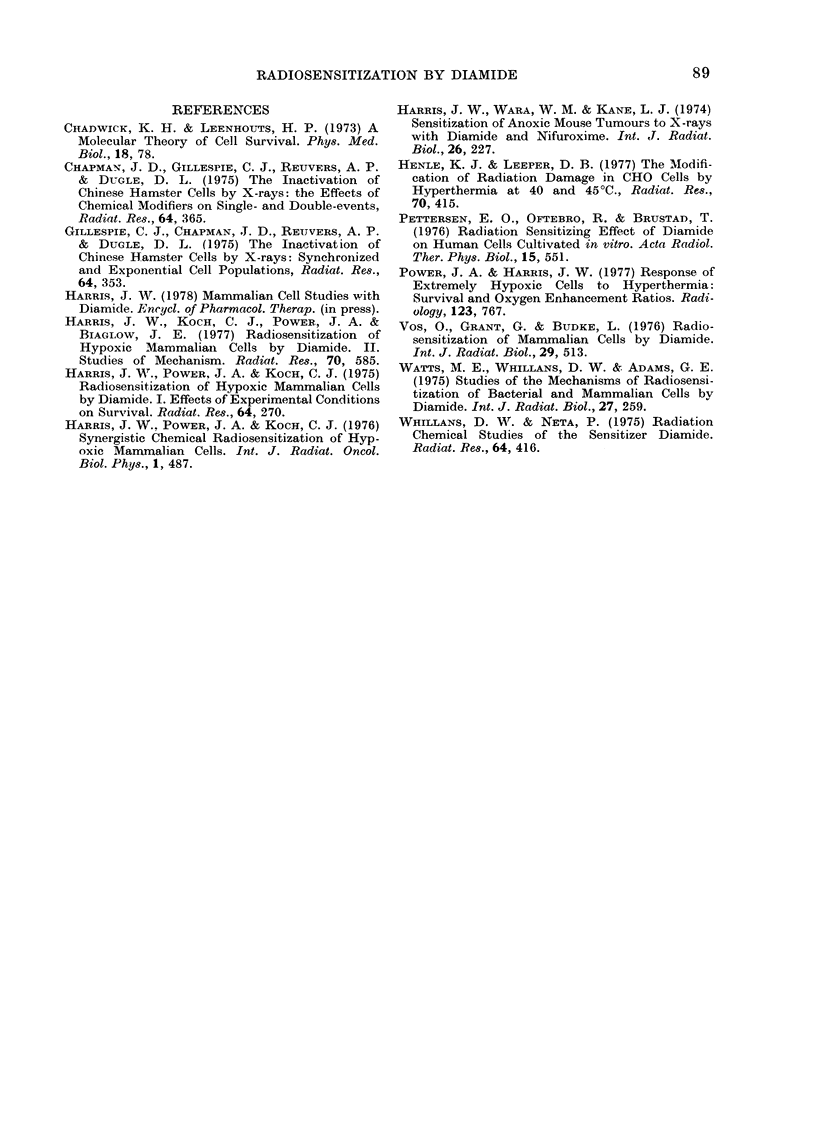Abstract
Diamide (diazenedicarboxylic acid bis [N,N′-dimethylamide]) is a hypoxic radiosensitizer that has at least two mechanisms of action, decreasing the survival curve shoulder at low concentrations and increasing the slope at high concentrations. Our present focus is on the shoulder effect, which we believe to be due to oxidation of cellular reducing species that normally effect rapid chemical repair of radiation-induced lesions.
In the present studies, we analysed survival curves for several cell lines to ascertain whether diamide has selective effects on the α (single-hit) and β (double-hit) components of the linear quadratic model. This analysis indicates that low concentrations of diamide (those that decrease the shoulder) selectively enhance α, whereas high concentrations (those that increase the slope) also increase β. The inference is that combinations of diamide with sensitizers that affect only β, such as misonidazole, should greatly increase the net sensitization obtainable.
In current studies we are testing the validity of this hypothesis and examining the interactions between sensitizers and other shoulder-modifying treatments (e.g., 40°C hyperthermia, Actinomycin D). Preliminary results indicate that appropriate combinations greatly increase cell-kill per rad in the low-dose region of the hypoxic survival curve.
Full text
PDF





Selected References
These references are in PubMed. This may not be the complete list of references from this article.
- Chadwick K. H., Leenhouts H. P. A molecular theory of cell survival. Phys Med Biol. 1973 Jan;18(1):78–87. doi: 10.1088/0031-9155/18/1/007. [DOI] [PubMed] [Google Scholar]
- Chapman J. D., Gillespie C. J., Reuvers A. P., Dugle D. L. The inactivation of Chinese hamster cells by x rays: the effects of chemical modifiers on single- and double-events. Radiat Res. 1975 Nov;64(2):365–375. [PubMed] [Google Scholar]
- Gillespie C. J., Chapman J. D., Reuvers A. P., Dugle D. L. The inactivation of Chinese hamster cells by x rays: synchronized and exponential cell populations. Radiat Res. 1975 Nov;64(2):353–364. [PubMed] [Google Scholar]
- Harris J. W., Koch C. J., Power J. A., Biaglow J. E. Radiosensitization of hypoxic mammalian cells by diamide. II. Studies of mechanism. Radiat Res. 1977 Jun;70(3):585–596. [PubMed] [Google Scholar]
- Harris J. W., Power J. A., Koch C. J. Radiosensitization of hypoxic mammalian cells by diamide. I. Effects of experimental conditions on survival. Radiat Res. 1975 Nov;64(2):270–280. [PubMed] [Google Scholar]
- Harris J. W., Power J. A., Koch C. J. Synergistic chemical radiosensitization of hypoxic mammalian cells. Int J Radiat Oncol Biol Phys. 1976 Mar-Apr;1(5-6):487–489. doi: 10.1016/0360-3016(76)90015-8. [DOI] [PubMed] [Google Scholar]
- Harris J. W., Wara W. M., Kane L. J. Sensitization of anoxic mouse tumours to x-rays with diamide and nifuroxime. Int J Radiat Biol Relat Stud Phys Chem Med. 1974 Sep;26(3):227–235. doi: 10.1080/09553007414551191. [DOI] [PubMed] [Google Scholar]
- Henle K. J., Leeper D. B. The modification of radiation damage in CHO cells by hyperthermia at 40 and 45 degrees C1. Radiat Res. 1977 May;70(2):415–424. [PubMed] [Google Scholar]
- Pettersen E. O., Oftebro R., Brustad T. Radiation sensitizing effect of diamide on human cells cultivated in vitro. Acta Radiol Ther Phys Biol. 1976 Dec;15(6):551–559. doi: 10.3109/02841867609131980. [DOI] [PubMed] [Google Scholar]
- Power J. A., Harris J. W. Response of extremely hypoxic cells to hyperthermia: survival and oxygen enhancement ratios. Radiology. 1977 Jun;123(3):767–770. doi: 10.1148/123.3.767. [DOI] [PubMed] [Google Scholar]
- Vos O., Grant G. A., Budke L. Radiosensitization of mammalian cells by diamide. Int J Radiat Biol Relat Stud Phys Chem Med. 1976 Jun;29(6):513–522. doi: 10.1080/09553007614550611. [DOI] [PubMed] [Google Scholar]
- Watts M. E., Whillans D. W., Adams G. E. Studies of the mechanisms of radiosensitization of bacterial and mammalian cells by Diamide. Int J Radiat Biol Relat Stud Phys Chem Med. 1975 Mar;27(3):259–270. doi: 10.1080/09553007514551551. [DOI] [PubMed] [Google Scholar]
- Whillans D. W., Neta P. Radiation chemical studies of the sensitizer Diamide. Radiat Res. 1975 Dec;64(3):416–430. [PubMed] [Google Scholar]


